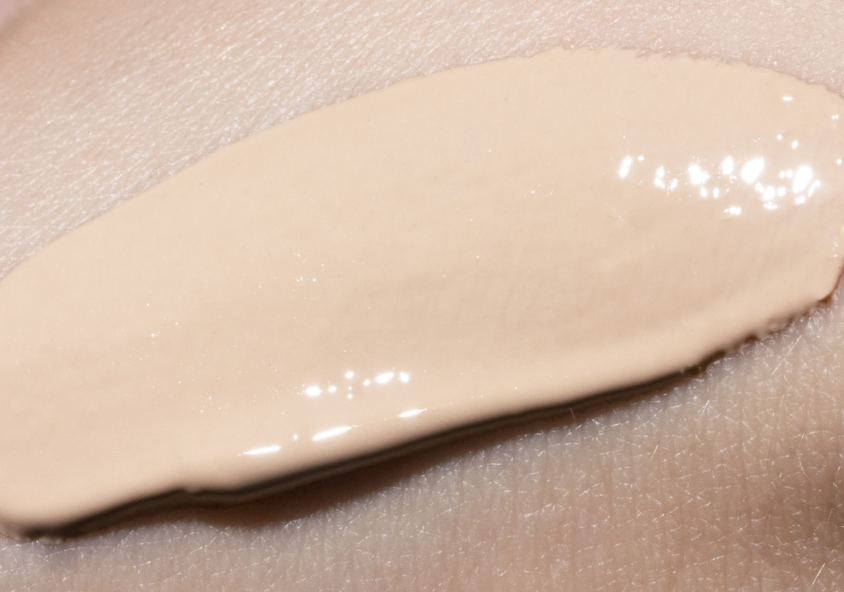In the quest for healthy, radiant, and youthful skin, there is an often overlooked hero that takes center stage: sunscreen. While skincare enthusiasts diligently follow cleansing and moisturizing rituals, the importance of incorporating sunscreen into your daily skincare routine cannot be overstated.
Using sunscreen is one of the best (and, in my opinion, the easiest) ways to protect the appearance and health of your skin at any age. For those with acne-prone skin, it’s crucial to choose products that are non-comedogenic to avoid clogging pores and triggering breakouts. It’s also important to use a sunscreen that’s specifically formulated for aging skin, as these products often contain added antioxidants and anti-aging ingredients that cater to those with mature skin.
Sunscreen is not just for preventing sunburn. If used regularly, it also helps reduce premature aging and the risk of skin cancer.
I have prepared this article to further explain the difference between mineral and chemical sunscreens and which one you should choose. I will also explain why sunscreen should be an integral part of your daily skincare routine and some other facts and tips to ensure your skin receives the best care.
What is mineral sunscreen?
An all-mineral sunscreen means it uses only zinc oxide and/or titanium dioxide as the ingredients that provide sun protection. Mineral (also called physical) sunscreens reflect ultraviolet (UV) rays, literally creating a physical separation between you and the sun.
To find out if the sunscreen you’ve chosen is mineral or chemical, the easiest way is to check the ingredients list on the packaging. Pay attention to what “active ingredients” have been used; if it’s zinc oxide or titanium dioxide (or both) and nothing else, then you can safely say you’re looking at a mineral sunscreen.
I would like to point out that when it comes to mineral sunscreen, there is no such thing as invisible mineral sunscreen. By nature, mineral active ingredients (zinc oxide and titanium dioxide) are white powders, which makes them very difficult to apply transparently. For this reason, you often see white halos or ghostly hues left by mineral sunscreens, especially on darker skin tones. To avoid such problems, sunscreens tend to have a slight tint to match the color of the skin's surface.
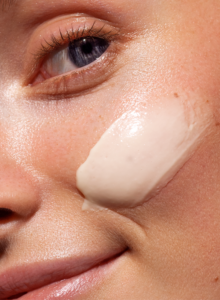
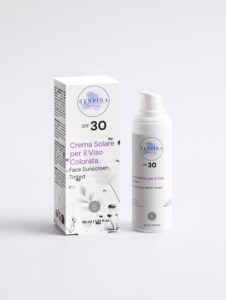
What is chemical sunscreen?
Chemical sunscreens use ingredients such as Avobenzone (butyl methoxydibenzoylmethane), Octinoxate (ethylhexyl methoxycinnamate), Octocrylene (octocrylene), Homosalate (benzoic acid, 2-hydroxy-, 3, 3, 5-trimethylcyclohexyl ester), Oxybenzone (benzophenone-3), Ethylhexyl Salicylate (octisalate), and others. While mineral sunscreens reflect UV rays, chemical sunscreens absorb UV rays and convert them into heat as they penetrate the skin.
Recent studies have found that chemical SPFs can enter the bloodstream. For some people, chemical sunscreens also tend to sting or cause allergic reactions when they penetrate the skin. This usually tends to happen in people with sensitive skin or skin that is more prone to allergic reactions.
To ensure the best protection, chemical sunscreens should be reapplied every 2 hours, while mineral sunscreens are effective as long as they remain on the skin.

What is SPF?
Sun Protection Factor (SPF) is the sunscreen's ability to protect against a specific portion of UV light called UVB. UVB rays are responsible for superficial sun damage, causing redness and dark spots (hyperpigmentation) on the skin.
There are two more portions of UV light:
UVC Rays (they do not pass through the Earth's atmosphere)
UVA rays (they penetrate deep into the skin and cause collagen to break down at a faster rate).
A good broad-spectrum sunscreen will protect against both UVB and UVA rays.
How do the sun’s harmful UV rays work?
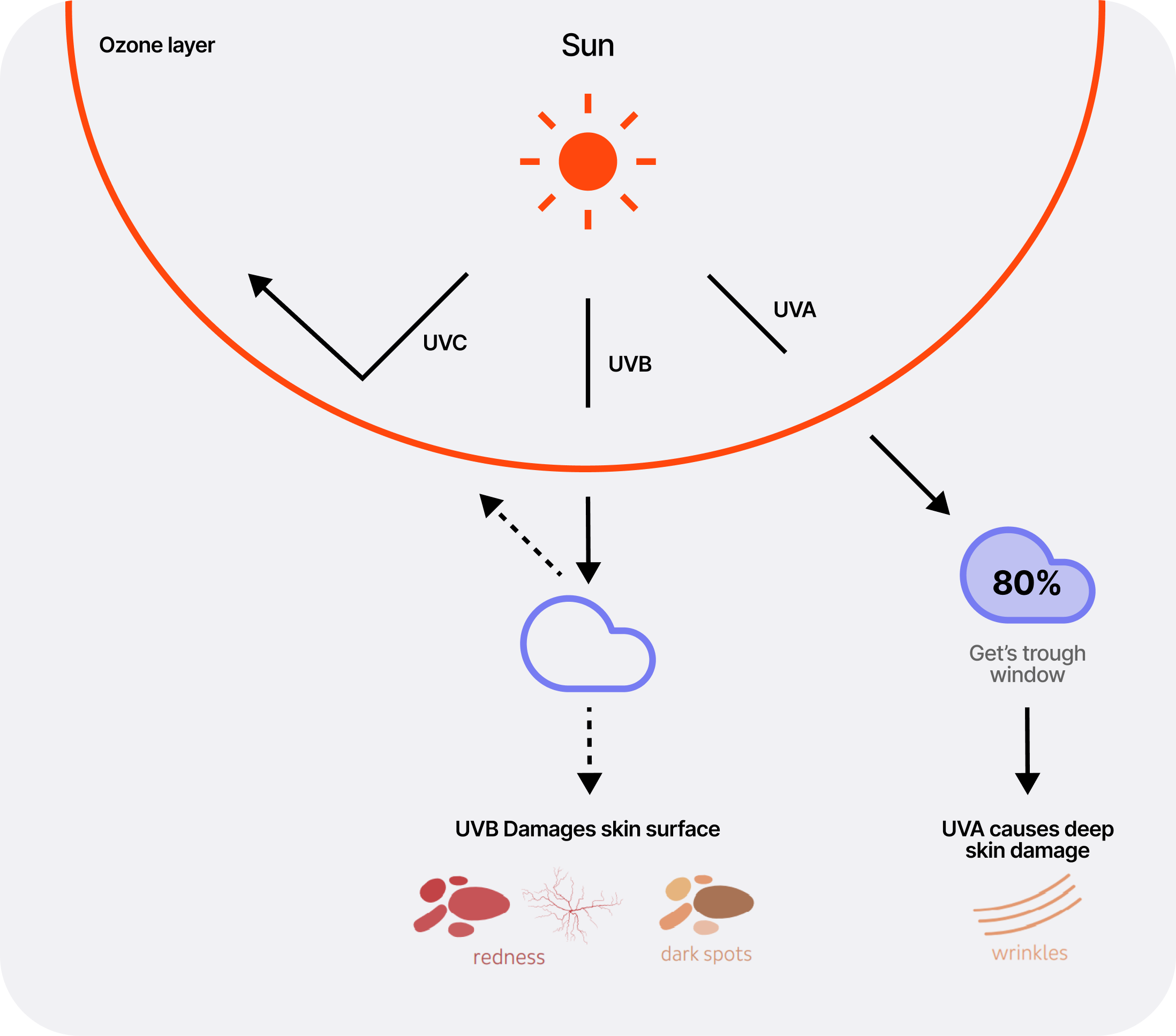
For everyday use, I recommend a sunscreen with an SPF of at least 30. Knowing when and how to apply sunscreen is key to optimally protecting your skin from UV rays. If you spend time outdoors, it’s best to choose a product with SPF 50. In all my years working in the skincare industry, I can tell you that most people don’t use sunscreen as much as they should, so higher SPFs help compensate for the reduced application. To ensure effective protection, apply sunscreen generously to all exposed areas of skin.
But, being a huge fan of SPF myself, I’m here to convince you to use sunscreen daily all year round!
Sunscreen in your skincare routine
Believe it or not, the sun continues to shine and shine even when it’s cloudy or snowing. That alone should be a compelling reason to start using sunscreen every single day as part of your morning skincare routine. But it actually has other benefits.
Applying sunscreen is a vital step in protecting your skin from UV damage, even when you are indoors. Sunscreens help prevent skin aging. So, one key to a youthful appearance and fewer wrinkles is actually a good skincare routine, which includes a daily dose of sunscreen.
When it comes specifically to Face Care, sunscreen should be applied every morning to your face and neck. (I would also argue that it should be applied to your hands, too, but we’re here to talk specifically about facial care.) You don’t need much: about half a teaspoon to protect your face and neck will do just fine.
As long as your sunscreen is at least SPF 30, water-resistant (a must on swim days), and broad-spectrum, it doesn’t matter what order you apply your skincare products in. However, I recommend applying it as the last step in your skincare routine, after your moisturizer and before your makeup.
Martina's Tips: How to Protect Your Skin from the Sun?
- Shade from direct sunlight: On sunny days, choose the side of the street with more shade to protect your skin.
- Choose light clothes, that cover the whole body in summer.
- On warm and sunny days wear a hat or a brim hat to create more shade over your eyes.
- Wear sunglasses! Because the skin around the eyes is the most sensitive and thinnest, signs of aging appear faster around the eyes.
Let's say it's summer and you're using products from our range Respira SkinCare. Here's how you should lay out your skincare products in the morning step by step:
1 – Cleanser: cleansing foam or clarifying gel, depending on the skin type (in the evening, to remove traces of sunscreen, it is better to use gentle cleansing milk and clarifying gel or face and body cleanser for sensitive skin).
2 – Toner purifying toner or hydrating toner, depending on your skin type.
3 – Serum: hydrating serum, Double Hydration Boost Gel or Anti-Age Peptide Serum
4 – Empowering: Antioxidant Booster Gel
5 – Moisturizing cream: Moisturizing, Oil-free Gel or Moisturizing day cream, depending on your skin type.
6 – Sunscreen: Face Sunscreen Tinted SPF30 or Mineral Sunscreen SPF30 Face & Body
7 – Makeup: If your last step includes foundation, make sure it has the SPF protection you want.
Curious about how to arrange your skincare products during other seasons? Check out our guide qui.
How to choose a good sunscreen
Here are some things to remember when choosing a sunscreen:
Don't be fooled by high SPF labels. I recommend choosing a sunscreen with an SPF between 15 and 30, because, first, an additional SPF level provides only marginal protection. And, second, a higher SPF number can tempt you to stay in the sun too long. Even if you don’t burn, your skin can suffer long-term damage.
Avoid sprays. While they may seem easier and more convenient to apply, sprays cloud the air with tiny particles, which may not be safe to breathe. They are also more likely to not provide a uniform, thick, and even layer enough to provide adequate UV protection. Another reason to avoid sprays is that it is nearly impossible to make a mineral sunscreen that has great usability, and they are usually loaded with chemical sunscreen actives.
Is it suitable for children? Toddlers and children usually have sunscreens specifically designed for them, as their skin is particularly sensitive to UV rays and chemical allergens. It is advisable to consult your child's pediatrician to find out which type of sunscreen is best suited to the needs of their skin. As for newborns, most manufacturers do not recommend using sunscreen on newborns, and instead they should be kept out of direct sunlight as much as possible. This is because their skin is not yet protected by melanin.
Consider your skin type. If you have dry skin, opt for hydrating formulas that improve moisture retention and support the health of the skin barrier. For those with oily skin, choose oil-free or gel-based formulas to effectively manage your skin concerns while providing adequate sun protection.
Both of our sunscreens (for face and body and one just for the face), are mineral sunscreens SPF30 and they are certified ECOCERT COSMOS. We have spent almost 6 years creating the right formulas (and we are constantly trying to improve them) that are effective and enjoyable to use. It is important to use sunscreen to cover the entire body, ensuring adequate protection from sun damage.
It is ideal for those who love spending time in the sun, whether it is doing outdoor activities or simply enjoying a cup of coffee outside the café at the sunniest table. Prolonged exposure to the sun can lead to skin aging and other skin problems, highlighting the need for sunscreen. We have tried to create one that is suitable for most skin types. Although it has a tint, it does not work like a foundation. It blends easily into the skin, without leaving a white cast.

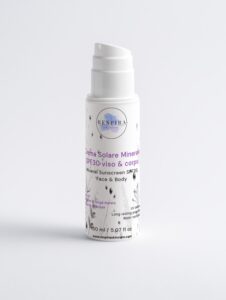
In closing, I just want to say that no matter what sunscreen you choose, try to use it regularly and whenever you are in the sun. If possible, try to enjoy the summer in the shade rather than in direct sunlight. And remember, your skin will only ever be as good as your skincare routine.
Author: Martina

